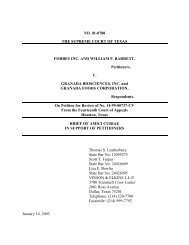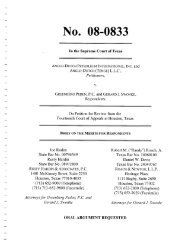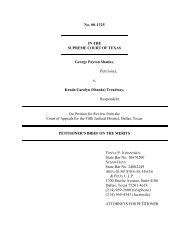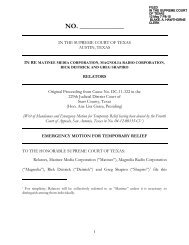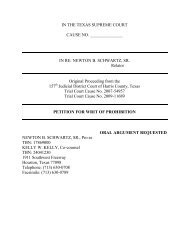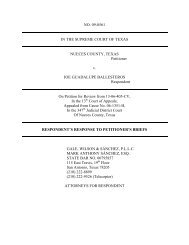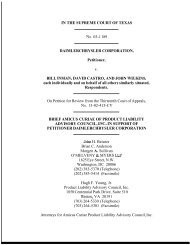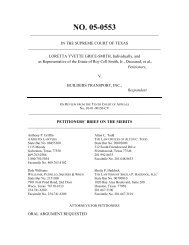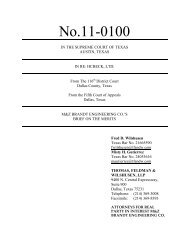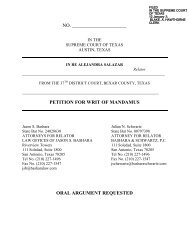NO. 10-0859 - Supreme Court of Texas
NO. 10-0859 - Supreme Court of Texas
NO. 10-0859 - Supreme Court of Texas
You also want an ePaper? Increase the reach of your titles
YUMPU automatically turns print PDFs into web optimized ePapers that Google loves.
acknowledged the Abel Assessment has since been roundly rejected by courts across the<br />
state and the country. 20<strong>10</strong> WL 2789649, at *29 n.22 (collecting cases). The court <strong>of</strong><br />
appeals’ non-analysis leads to a conclusion that is unsupported by the record and flies in<br />
the face <strong>of</strong> Robinson. The court should have considered whether the data Willoughby<br />
relied upon was “valid support for the opinion reached.” Whirlpool, 298 S.W.3d at 642.<br />
If the habeas court and court <strong>of</strong> appeals had properly “scrutinized” the new evidence<br />
regarding the actual reliability and accuracy (or lack there<strong>of</strong>) <strong>of</strong> the Abel Assessment,<br />
they could only have concluded that it was inadmissible. See Robinson, 923 S.W.2d at<br />
554 (“It is especially important that trial judges scrutinize pr<strong>of</strong>fered evidence for<br />
scientific reliability when it is based upon novel scientific theories, sometimes referred to<br />
as ‘junk science.’”). The courts’ failure to do so was error; therefore, this <strong>Court</strong> must<br />
consider whether this error constituted “harm.” 18<br />
B. Because the State’s reliance on Willoughby’s testimony directly<br />
contributed to the sentence M.P.A. received, the error was harmful.<br />
Error is harmful when it “cause[s] the rendition <strong>of</strong> an improper judgment.”<br />
Cent. Expressway Signs, 302 S.W.3d at 870; see also Ex Parte Fierro, 934 S.W.2d 370,<br />
375 (Tex. Crim. App. 1996) (“[A]pplicant has the burden to prove by a preponderance <strong>of</strong><br />
the evidence that the error contributed to his conviction or punishment.”). Here, the State<br />
18<br />
As noted above, the court <strong>of</strong> appeals held that Willoughby’s testimony would have been admitted<br />
even if the trial court had known the truth about the reliability and accuracy <strong>of</strong> the Abel Assessment.<br />
Nevertheless, even if this <strong>Court</strong> determines that somehow this conclusion was not error, it should still<br />
consider whether such a finding would have been upheld on direct appeal had Willoughby testified<br />
truthfully and whether, in any event, the jury would have been entitled to know that Willoughby’s<br />
testimony was almost completely false and unsupported before sentencing M.P.A. to twenty years’<br />
imprisonment.<br />
14




